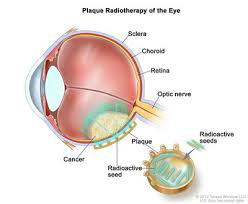Choroidal melanoma
This malignant tumour, occurring within the eye requires urgent sub-specialist assessment and treatment. Assessment includes investigations such as Flourescein Angiography, EDI-OCT and Ultrasonography. The tumours require either radiation or laser treatment or a combination of the two. Dr Warrier can assess and provide treatment for these rare but dangerous lesions. All radiation treatment is done, alongside the radiation oncologists, at the Mater Hospital in South Brisbane, where Dr Warrier is a Visiting Medical Officer (VMO).
These tumours can sometimes spread outside of the eye. The tendency of the tumour to do so depends on the genetic characteristics of the TUMOUR. (Not of the patient i.e. you cannot pass these on, nor has it been passed on to you by your parents). To determine this, you will have to have a biopsy of the tumour. Dr Warrier offers diagnostic and prognostic biopsies of ocular tumours. These can either be done from the inside or the outside of the eye.
Choroidal melanoma with characteristic pigmented appearance.
Treatments for Choroidal melanoma
Plaque brachytherapy
This focal radiation allows treatment localised to within the eye. It involves 2 surgical procedures; 1 to insert the radio-active plaque onto the eye and a second procedure to remove it. These are usually done under General Anaesthesia (GA) though this can vary from patient to patient. Whilst the plaque is on your eye, you will be an in-patient at the Mater Hospital, staying in a lead-lined room on the 10th floor. Please be forewarned that the waiting time CAN BE VERY BORING! So bring a good book or your laptop. Visitors are allowed but must wear a lead vest. There will be between 2- 3 eye drops that you will have to use for about 2 months after the surgery. This procedure is very well tolerated with a success rate of 90% with a single radiation treatment. You will, however, always feel that the operated eye ‘feels’ different to the other eye. Radiation therapy in the eye can cause local side effects such as cataract, dry eye and some times affect blood vessels. Most of these side effects can be successfully managed.
Laser
These treatments can be offered as day procedures in Dr Warrier’s consulting rooms. They can be used depending on your tumour type and characteristics and will be discussed with you if appropriate.
Trans-retinal biopsy
This is performed by passing a fine 25g vitreous cutter (vacuum cleaner) through the eye, into the middle of the tumour and taking small samples for analysis. This can be done before treatment to determine the nature of the lesion or approximately a month after radiation therapy for tumours located towards the back of the eye, for genetic analysis.
Trans-scleral biopsy
This is done at the time of plaque surgery, by creating a small flap in the wall of the eye, and removing a small sample for analysis. The flap is then closed and the area irradiated.
Enucleation
This operation involves complete removal of the eye, including the tumour, when it is too big to treat in any other fashion. The operation is done under general anaesthesia (GA), usually with a stay in hospital to manage any discomfort for a few days after. Done by an experienced surgeon such as Dr Warrier, this is very well tolerated by patients. The muscles around the eye are sutured to an implant which is placed behind the eye to make up for the space by the removed eye. Working alongside Brisbane’s excellent prothetists, patients can expect an excellent cosmetic outcome about 8-10 weeks following surgery. The new ‘artificial eye’ is a thin implant placed between the lids like a thick contact lens, which is matched to the other eye for colour etc and moves to a certain extent


